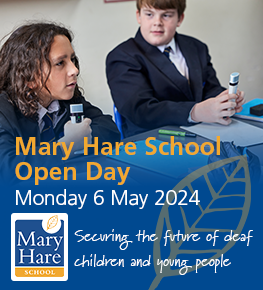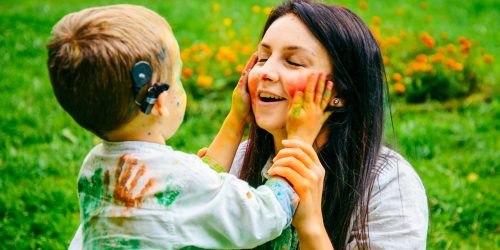3.4. Pure-tone audiometry
Air conduction
Introduction:
As the infant gets older maintaining focus and attention with VRA or similar assessments can be harder and may result in unreliable responses.
Children around the age of four years old can take part in pure-tone audiometry (PTA) assessments. This allows ear-specific thresholds to be obtained as the child responds to specific pure-tone sounds delivered via circum-aural headphones, insert earphones, or bone conductor headphones.
As this assessment will focus on obtaining specific frequency thresholds, it can take some time to achieve results. It requires the child to focus and cooperate for around 20 minutes.
Procedure:
Depending on the age and interest of the child, the assessment can be carried out by one audiologist or two audiologists (one tester and one presenter).
The audiologist will explain to the child that sounds will be played through the headphones. The child will be seated so they are unable to see the audiologist presenting the sounds.
Audiologists ideally want to gain threshold levels across the speech frequency, and the process follows a specific order: 1 kHz, 2kHz, 4kHz, 8 kHz, 500 Hz, 250 Hz, 1 kHz
This is not always possible when testing infants. The aim is to obtain four points on both ears: 1 kHz, 4 kHz, 500 Hz, and 2 kHz. However, this will be dependent on the age and ability of the child and the clinical need. In some cases, only one or two points will be obtained. In other cases, for example with older children who are hearing aided, where possible 3 kHz and 6 kHz points are also obtained. This provides more accurate information for audiologists to program hearing aids.
At each frequency, the initial sound is presented at approximately 30 decibels (dB) above the estimated threshold, for example, the sound will be presented at 40 decibels Hearing Level (dBHL) if the child has hearing within normal levels. Once the child responds, the ‘-10 dB + 5 dB’ pattern is followed until responses at the same level are made for <50% of attempts. This is carried out on both ears to gain bilateral results. There will be exemptions, which will be dependent on the infant and the required outcome of the assessment.
How the child responds:
The activities presented to the child will be determined by their age and interest. Older children will normally use the ‘response button’. The child will press the button each time they hear the sound, and this tends to be carried out by only one audiologist.
Younger children may still require more physical ‘cause/effect’ activities such as putting men in the boat, building a tower, or throwing balls in a bucket. Using a range of activities will require two audiologists.
Although the aim is to gain the full range of frequencies on both ears, this is not always possible. The child may become distracted or tired, which will result in unreliable responses. The audiologist will reduce the number of frequencies to test and aim to obtain 1 kHz and 4 kHz. Follow-up appointments can be arranged to gain a more detailed audiogram.
Bone conduction
This provides more information about the nature of the hearing levels obtained via air conduction.
A vibrating headphone is placed on the child’s head. The sound presented vibrates through the mastoid bone directly to the cochlear. This will identify if there is a middle ear issue. Results that are <10 dB than the air conduction results may suggest issues such as glue ear or cholesteatoma.
This, however, is not ear specific but rather gives the results for the better ear. To identify which ear is responding through bone conduction, the process of masking can take place.
Masking noise (whooshing sound) is presented to the ‘non-test’ ear. This is to prevent that ear from detecting the test signal. The testing sound is then presented into the test ear. The masking noise volume is increased until the child no longer detects and responds to the test signal.
Children participating in masking must be able to respond appropriately to the signal and not the masking noise. They may require some ‘practice runs’ to become familiar with the sounds; however, it may not be appropriate for all children.
Considerations for QToDs
- How can the family be prepared for this assessment? Support the family with activities to help both family and child understand what is involved.
- The accuracy of the results is very dependent on the cooperation and interest of the infant.
- The family need to understand they may hear some sounds that their child does not respond to; it is important they do not give any visual cues such as flinching or sighing.
- The child needs to understand the expectations of the assessment. Conditioning activities could take place by the QToD prior to the audiology appointment.
Further reading:
For further information refer to:
Next pages in section 3
3.5 Assessing children with additional needs
3.6 Auditory neuropathy spectrum disorder (ANSD)
3.7 Auditory processing disorder (APD)
3.8 Cochlear implant assessment
3.9 Bone conduction implant assessment
Previous pages in section 3
3.1 Newborn hearing screening programme (NHSP)
3.3 Visual reinforcement audiometry
Other sections
- Section 1 Anatomy and physiology of the ear
- Section 2 Aetiology and types of deafness
- Section 4 Acoustics and physics of sound
- Section 5 Listening skills and functional hearing
- Section 6 Hearing technologies




